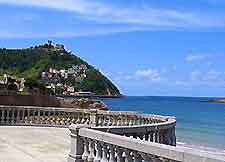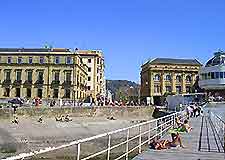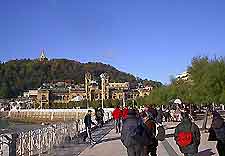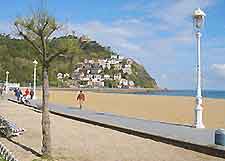San Sebastian Life and Visitor Travel Tips
(Donostia - San Sebastian, Gipuzkoa, Basque Country, Spain)

San Sebastian is major city within Spain's famous Basque country and has much to offer tourists. Those visiting San Sebastian will find that much of city life in the San Sebastian area is based around the picturesque La Concha Bay, which is known for its celebrity visitors.
Also, the waterfront around the San Sebastian Port (El Puerto) has become a tourist hotspot and has been greatly developed with tourism in mind, offering a range of restaurants and bars.
Travel tips and general tourist advice is readily available at San Sebastian's tourist information bureaus and kiosks, with a range of leaflets often also on offer at top attractions and hotel foyers. With three main beaches in San Sebastian - the Playa de Ondaretta, the Playa de Gros and the Playa de la Concha, there are plenty of places to relax in the sunshine and enjoy the views.

Tourism and Tourist Information (Oficinas de Turismo)
Offering a range of up-to-date tourist advice and travel tips, San Sebastian's popular Centro de Attractión y Turismo can be found along the Boulevard Reina Regente and is open daily. Offering comprehensive tourist information and leaflets about both San Sebastian and the surrounding Basque country, additional city information can be found at the bus and train stations.
Further tourist information can also be found at the popular DonostiNet Internet café along the Calle de Narrica, and at the Wash 'n Dry laundrette on Calle de Iparragirre.
Centro de Attractión y Turismo
Address: Boulevard Reina Regente 3, San Sebastian (Donostia), Spain
Tel: +34 943 481 166
Open hours: June to September, Monday to Saturday - 08:00 to 20:00, Sunday - 10:00 to 14:00; October to May, Monday to Saturday - 09:00 to 14:00 and 15:30 to 19:00, Sunday - 10:00 to 14:00

Language
Spanish is the third most widely spoken language in the world, behind Chinese and English. Although Spanish is the main language in San Sebastian, English, French and German are usually understood at most attractions, entertainment venues, hotels, restaurants and bars that cater for tourism. Castilian Spanish is the official language in the San Sebastian area, although nearby regions may speak Basque, Catalan and Galician versions.
Tipping
Tipping is quite discretionary in San Sebastian, with taxi drivers usually being pleased with a little rounding up when receiving payment, although this is by no means mandatory. Restaurants always include service charges by law and these should be clearly indicated on the menus, although a tip of some kind will still be expected and very much appreciated. Hotel staff, such as luggage handlers, happily accept a small tip, which may be just one or two Euros. Generally, no other public service workers in San Sebastian expect tips.

Places of Worship
The national religion of San Sebastian and throughout Spain is Roman Catholic, although plenty of other faiths and major religious beliefs are present in San Sebastian, including Protestants and Muslims. There are many local churches and chapels in the area, holding regular services, particularly on Sundays. San Sebastian's most important church is the Basilica de Santa Maria del Coro, which dates back to the 16th century.
Smoking
As from 2006, Spanish law restricts smoking in most public spaces in San Sebastian, including offices, restaurants, places serving food, and venues catering specifically for children. No-smoking areas are always clearly sign posted and designated smoking areas or separate rooms are often available at both bars and pubs in San Sebastian. However, many people choose to smoke only outdoors, or when others nearby are already smoking.
Tips for Using the Euro
The Euro is made up of eight coins and seven paper notes and was introduced on January 1, 2002. The 12 original members of the European Union - Austria, Belgium, Finland, France, Germany, Greece, Ireland, Italy, Luxembourg, Netherlands,
Portugal, and Spain - planned the event for many years in advance, deciding upon a specific conversion rate for each country's national currency. The colourful Euro bills, which include holograms and shades of green, yellow, blue, mauve, and orange, are identical throughout Europe. Coins have one common and one national side, but they can be used in any of the member countries, regardless of the country of issue. Old currencies are no longer accepted as legal tender, although major banks will happily convert them into Euros.
Telephones and Emergency Numbers
- Emergencies in San Sebastian - for police dial 091 (national) or 092 (local)
- For fire emergencies in San Sebastian - dial 080 or 085 and for an ambulance dial 409 5530
- To call from one city code to another in San Sebastian- first dial '0' followed by the Spanish city code and the main telephone number
Safety
Typical of all big cities, bag snatchers and pickpockets are present in San Sebastian, so always be aware of your belongings and personal baggage, particularly in large crowds. Wear handbags and cameras across your body, and consider storing money in a concealed belts when visiting San Sebastian. Also, never leave valuables on show in both car parks and hotel rooms.
Taxes
VAT (IVA) is always included in the price and refunds are unusual in San Sebastian and throughout Spain. Tourists visiting San Sebastian from countries outside of the EU may be able to claim a tax refund if the item was purchased for personal use and cost more than a certain amount. Ask the shopkeeper for additional information if required.
 San Sebastian is major city within Spain's famous Basque country and has much to offer tourists. Those visiting San Sebastian will find that much of city life in the San Sebastian area is based around the picturesque La Concha Bay, which is known for its celebrity visitors.
San Sebastian is major city within Spain's famous Basque country and has much to offer tourists. Those visiting San Sebastian will find that much of city life in the San Sebastian area is based around the picturesque La Concha Bay, which is known for its celebrity visitors.

